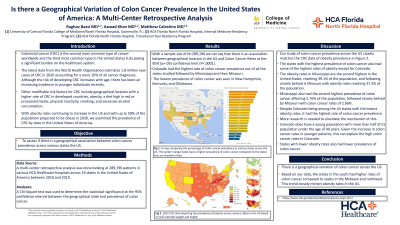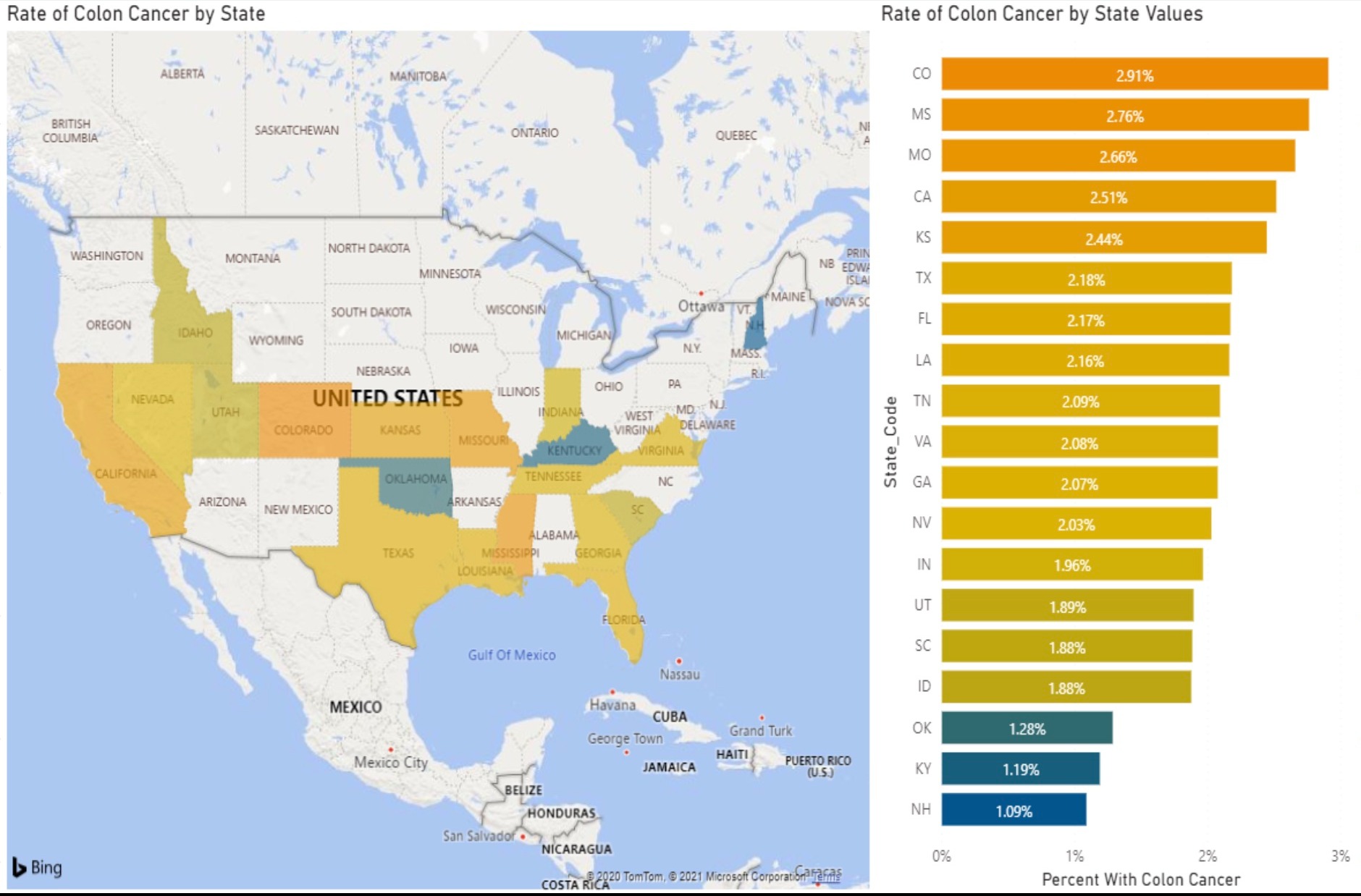Tuesday Poster Session
Category: Colon
P3043 - Is There a Geographical Variation of Colon Cancer Prevalence in the United States of America: A Multi-Center Retrospective Analysis
Tuesday, October 24, 2023
10:30 AM - 4:00 PM PT
Location: Exhibit Hall

Has Audio

Raghav Bassi, MD
University of Central Florida
Gainesville, FL
Presenting Author(s)
Award: Presidential Poster Award
Raghav Bassi, MD, Awaad Khan, MD, Matthew Calestino, MD
University of Central Florida, Gainesville, FL
Introduction: Colorectal cancer (CRC) remains one of the most common types of cancer worldwide and poses a significant burden on our healthcare system. The latest data from the World Health Organization estimates 1.8 million new cases of CRC in 2020, accounting for 10% of all cancer diagnosis. Although the risk for developing CRC increases with age, there has been an increasing incidence in younger individuals. Other modifiable risk factors for CRC include geographical location with a higher rate of CRC in developed countries, obesity, a diet high in red or processed meats, physical inactivity, smoking and excessive alcohol consumption. With obesity rates continuing to increase in the United States (US) and with up to 50% of the population projected to be obese in 2030, we examined the prevalence of CRC by state in the United States of America.
Methods: A multi-center retrospective analysis was done looking at 289,196 patients across various hospitals in 19 states between 2016 and 2019. A Chi Square test was used looking for statistical significance between geographical states and the rate of colon cancer.
Results: With a sample size of N=289,196 there is an association between State and Colon Cancer Rates at the 95% (α=.05) confidence limit (P< .0001). Colorado had the highest rate of colon cancer prevalence out of all the states studied followed by Mississippi and then Missouri. The lowest prevalence of colon cancer was seen in New Hampshire, Kentucky, and Oklahoma.
Discussion: Two of the top three states with the highest frequency of colon cancer also had the highest obesity rates in the United States (Fig 1). Mississippi has the second-highest obesity rate in the country, impacting 39.1% of the population. Missouri comes close behind, with obesity afflicting 37.3% of the population. Despite having one of the lowest obesity rates in the country, Colorado had the highest rate of colon cancer prevalence. This is attributed to Colorado's rapidly aging population, with more than half of the state's population becoming 65 or older between 2009 and 2019, corresponding to the timeline of our study. The southern and midwestern states continue to have some of the highest colon cancer prevalence rates, which can be ascribed to poor lifestyle and nutritional choices. With obesity rates in the US continuing to increase coupled with high red meat consumption, we estimate that the prevalence of colon cancer will rise as well, emphasizing the importance of routine screening colonoscopies.

Disclosures:
Raghav Bassi, MD, Awaad Khan, MD, Matthew Calestino, MD. P3043 - Is There a Geographical Variation of Colon Cancer Prevalence in the United States of America: A Multi-Center Retrospective Analysis, ACG 2023 Annual Scientific Meeting Abstracts. Vancouver, BC, Canada: American College of Gastroenterology.
Raghav Bassi, MD, Awaad Khan, MD, Matthew Calestino, MD
University of Central Florida, Gainesville, FL
Introduction: Colorectal cancer (CRC) remains one of the most common types of cancer worldwide and poses a significant burden on our healthcare system. The latest data from the World Health Organization estimates 1.8 million new cases of CRC in 2020, accounting for 10% of all cancer diagnosis. Although the risk for developing CRC increases with age, there has been an increasing incidence in younger individuals. Other modifiable risk factors for CRC include geographical location with a higher rate of CRC in developed countries, obesity, a diet high in red or processed meats, physical inactivity, smoking and excessive alcohol consumption. With obesity rates continuing to increase in the United States (US) and with up to 50% of the population projected to be obese in 2030, we examined the prevalence of CRC by state in the United States of America.
Methods: A multi-center retrospective analysis was done looking at 289,196 patients across various hospitals in 19 states between 2016 and 2019. A Chi Square test was used looking for statistical significance between geographical states and the rate of colon cancer.
Results: With a sample size of N=289,196 there is an association between State and Colon Cancer Rates at the 95% (α=.05) confidence limit (P< .0001). Colorado had the highest rate of colon cancer prevalence out of all the states studied followed by Mississippi and then Missouri. The lowest prevalence of colon cancer was seen in New Hampshire, Kentucky, and Oklahoma.
Discussion: Two of the top three states with the highest frequency of colon cancer also had the highest obesity rates in the United States (Fig 1). Mississippi has the second-highest obesity rate in the country, impacting 39.1% of the population. Missouri comes close behind, with obesity afflicting 37.3% of the population. Despite having one of the lowest obesity rates in the country, Colorado had the highest rate of colon cancer prevalence. This is attributed to Colorado's rapidly aging population, with more than half of the state's population becoming 65 or older between 2009 and 2019, corresponding to the timeline of our study. The southern and midwestern states continue to have some of the highest colon cancer prevalence rates, which can be ascribed to poor lifestyle and nutritional choices. With obesity rates in the US continuing to increase coupled with high red meat consumption, we estimate that the prevalence of colon cancer will rise as well, emphasizing the importance of routine screening colonoscopies.

Figure: Fig 1: A map of the United States revealing colon cancer prevalence in 19 states cross various hospitals between 2016 and 2019.
Disclosures:
Raghav Bassi indicated no relevant financial relationships.
Awaad Khan indicated no relevant financial relationships.
Matthew Calestino indicated no relevant financial relationships.
Raghav Bassi, MD, Awaad Khan, MD, Matthew Calestino, MD. P3043 - Is There a Geographical Variation of Colon Cancer Prevalence in the United States of America: A Multi-Center Retrospective Analysis, ACG 2023 Annual Scientific Meeting Abstracts. Vancouver, BC, Canada: American College of Gastroenterology.


